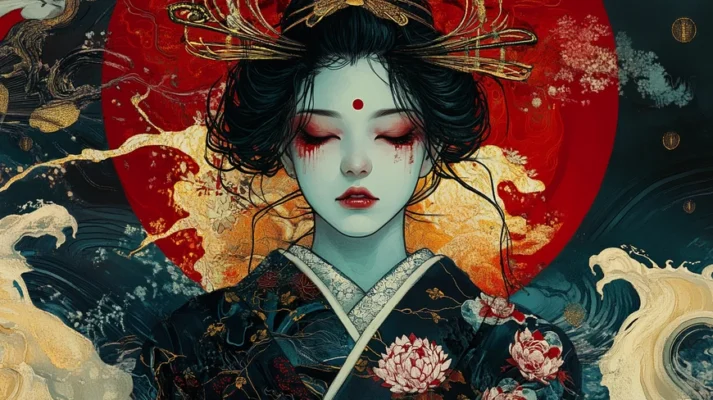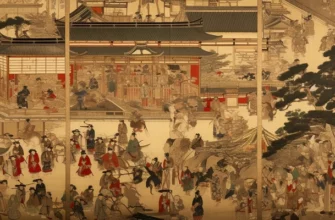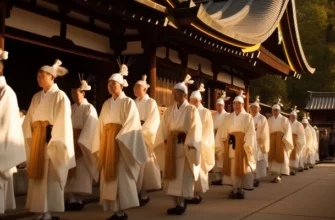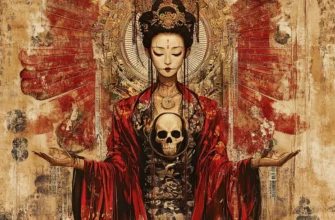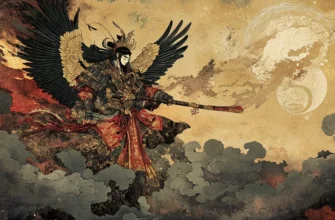Izanami is one of the key figures in Japanese mythology, the goddess of creation and death, who is the sister and wife of Izanagi. According to Japanese myths, Izanami and Izanagi created the first islands of Japan and many deities. Their union became a symbol of the beginning of life and the continuation of the family line.
The story of Izanami in Japanese legends includes the myth of her death during childbirth when she gave birth to the god of fire, Kugihame. After this tragedy, Izanami descended into the realm of the dead, Yamat, where she became the goddess of death. This led to Izanaki, having lost his wife, setting out in search of Izanami, but his encounter with her ended in tragedy: he saw her in a terrible state, which led to their final separation.
Izanami symbolizes not only death but also renewal, for without death there is no life. Her image is present in Japanese culture, particularly in temples and shrines, where she is worshipped as a goddess who ensures the cycle of life. Izanami remains an important figure in Japanese mythology, reflecting profound concepts of life, death, and continuity.
- The story of Izanami
- Description of the creation of Izanami and her connection to Izanagi.
- The Myth of the Creation of Japan
- Role in Japanese mythology
- The significance of Izanami as the goddess of life and death.
- Relationship with other gods
- Major myths about Izanami
- The Death of Izanami
- Cult and worship
- Temples and shrines
- How the image of Izanami has been preserved in modern Japanese culture
- Conclusion
The story of Izanami
Izanami, which translates as “she who invites,” is one of the most important figures in Japanese mythology. Her story is closely linked to legends about the creation of the world, as well as themes of life and death.
Origin
Izanami and her brother Izanagi were created from the primordial chaos when the goddess Ko and the god Izanagi emerged from the water. Their union marked the beginning of creation. Together, they descended to earth to create the first islands of Japan. According to the myths, they used a magical rope to spin, and thus the islands of Nippon, Honshu, Kyushu, and Shikoku were created.
The myth of creation
After the creation of the islands, Izanami and Izanagi began to give birth to gods. However, during the birth of the god of fire, Kugihami, Izanami was seriously injured. She died in agony, which was a great sorrow for Izanagi.
Legacy and death
After her death, Izanami descended into the realm of the dead, called Yamat. Izanagi, overcome with grief, decided to find his wife. He descended to Yamat, where he found Izanami. However, when he saw her in her terrible state, she became a symbol of death and disappointment for him. Their meeting ended tragically: Izanagi fled back to the world of the living, closing the door to the realm of the dead behind him.
Influence on Japanese mythology
Izanami became a symbol not only of death but also of renewal, as her story shows that death is an integral part of life. She remains an important figure in Japanese culture, and her image is often depicted in temples and shrines, where she is worshipped as a goddess who ensures the cycle of life.
Thus, the story of Izanami is profound and symbolic, reflecting the fundamental concepts of Japanese mythology about life, death, and the cyclical nature of existence.
Description of the creation of Izanami and her connection to Izanagi.
Izanami and Izanagi are central figures in Japanese mythology who play a key role in the creation of the world. Their story is intertwined with themes of love, loss, and the continuity of life.
The origins of Izanami and Izanagi
According to Japanese mythology, Izanagi and Izanami were created from the primordial chaos when the world did not yet exist. They emerged from a divine element that gave them the power to create. Their creation was originally intended as part of a great cosmic harmony.
Joint creation
After their creation, Izanagi and Izanami were tasked with creating the earth. They descended to an island known as Kunisaki (Amisumi) and used a magical rope to spin it. This ritual led to the emergence of the first islands of Japan, such as Nippon, Honshu, Kyushu, and Shikoku. Their joint creation symbolized the unity and interconnection of the male and female principles.
Love and marriage
Izanaki and Izanami fell in love and got married. Their union became the basis for the creation of many gods, including the god of fire, Kugihime. However, during the birth of this god, Izanami suffered severe injuries, which became a turning point in their history.
Loss and tragedy
After the birth of Kugihime, Izanami died. Her death deeply affected Izanagi, who lost not only his wife but also a part of himself. He set out to search for Izanami in the realm of the dead, Yamat, to find her, but their meeting was tragic, as he saw her in a terrible state.
The significance of their relationship
The relationship between Izanami and Izanaki embodies the idea of harmony between the male and female principles, as well as the cyclical nature of life and death. Their story emphasizes the importance of the interaction between these two forces and points to the inevitability of loss and renewal, which is a central theme in Japanese mythology.
Thus, the creation of Izanami and her connection to Izanagi are important elements of Japanese mythology, reflecting profound philosophical concepts about life, love, and eternity.
The Myth of the Creation of Japan
The myth of the creation of Japan, known in Japanese mythology, describes how the gods Izanagi and Izanami created the first islands of Japan and the deities that inhabit this world. This myth has enormous cultural and symbolic significance for the Japanese people.
The beginning of creation
According to the myth, after the initial chaos, in which nothing existed, the first gods appeared. Among them were Izanagi (god of the male principle) and Izanami (goddess of the female principle). The gods were tasked with creating the earth. To do this, they used a magical rope to wrap around the island of Kun, which became the foundation of Japan.
Creation of the islands
First, Izanagi and Izanami created the island of Nippon, which became the first of the Japanese islands. They continued to create, and eventually the other main islands of Japan emerged: Honshu, Kyushu, and Shikoku. Each of the islands was created through rituals in which both deities participated.
The birth of the gods
After creating the islands, Izanagi and Izanami began to give birth to deities that were to correspond to different aspects of life. The first deity to appear was the god of the sea, Ninigi, followed by the gods of mountains, rivers, and the gods of agriculture and fertility. However, during the birth of the god of fire, Kugihama, Izanami suffered serious injuries that led to her death.
Tragedy and legacy
After Izanami’s death, Izanagi, overcome with grief, went to the realm of the dead, Yamat, to find his wife. However, the meeting with her turned out to be terrible — Izanami had turned into a terrifying creature, and this led to a final break between them.
This tragedy highlights the importance of the balance between life and death.
Significance of the myth
The myth of the creation of Japan reflects profound concepts related to life, death, and renewal. It points to the importance of nature and the deities that inhabit it, and emphasizes the interconnection between the male and female principles. This myth remains an integral part of Japanese culture, and the images of Izanagi and Izanami symbolize the creation and continuity of life, upon which Japanese identity is based.
Role in Japanese mythology
Izanami, as one of the most important goddesses in Japanese mythology, plays an important role in shaping the Japanese cosmos, culture, and spirituality. Her influence can be seen through several key aspects:
Creation of life
Izanami, together with Izanagi, is a symbol of creative power that embodies the feminine principle. Their joint creation of the first islands of Japan and the deities that inhabit them lays the foundation for understanding the importance of women in the process of birth and preservation of life. She symbolizes fertility and the feminine power necessary for the continuation of the family line.
Death and renewal
Izanami is also associated with the concept of death. After her death, she becomes the goddess of the realm of the dead, Yamat. This role gives her significance in the context of Japanese culture, where death is seen not as the end, but as part of the cycle of life. Her story and connection to Izanagi emphasize the importance of the balance between life and death, showing that one cannot exist without the other.
Symbolism of the feminine principle
As a goddess, Izanami embodies the feminine principle, which is important in Japanese mythology. Her image is often associated with nature, fertility, and renewal. She represents the maternal force that cares for all living things and thus becomes a symbol of everything related to motherhood and protection.
Relationship with other gods
Izanami has a great influence on other gods in the Japanese pantheon. Her descendants, who were created during her union with Izanagi, became the main deities who govern various aspects of life, such as agriculture, water, and fertility. This creates a hierarchy of gods that reflects the Japanese perception of the world and its elements.
Cult and worship
Modern Japanese people continue to honor Izanami, and there are temples and shrines dedicated to her in Japan. Her cult emphasizes the importance of connection with ancestors and nature, which is an integral part of Japanese spirituality.
Izanami’s role in Japanese mythology is multifaceted and symbolic. She embodies the concepts of creation, death, female power, and nature. Her image remains an important element of Japanese culture and spirituality, pointing to the inseparability of life and death, as well as the importance of the interconnection between the male and female principles.
The significance of Izanami as the goddess of life and death.
Izanami, as one of the main figures in Japanese mythology, occupies a unique place, embodying the concepts of life, death, and the cyclical nature of existence. Her role as the goddess of life and death has a deep symbolic meaning that reflects the Japanese worldview.
Creation of life
Izanami is a symbol of fertility and motherhood. Together with Izanagi, she created the first islands of Japan and many deities that provided for the vital aspects of society. Her creative power reflects the importance of the feminine principle, which brings new life into the world. In mythology, Izanami is associated with the natural cycles on which the prosperity of all living things depends.
Death as part of life
After her death, Izanami became the goddess of the realm of the dead, Yamat. This transition emphasizes the importance of death in the Japanese cultural context. Death is seen not as the end, but as a stage leading to renewal and new life. Thus, Izanami symbolizes the idea that life and death are closely connected and one cannot exist without the other.
The cyclical nature of existence
Izanami represents the concept of cyclicality that permeates Japanese mythology. Her story and relationship with Izanagi demonstrate how life and death are interconnected, forming a continuous cycle. After her death, Izanami remains an active figure in mythology, emphasizing the importance of remembering ancestors and their influence on modern life.
Spiritual worship
Izanami is revered not only as the goddess of life, but also as a symbol of wisdom who accepts death as an integral part of the life cycle. She teaches people to accept loss and find strength in it for a new beginning. This makes her a figure of respect and reverence, as her image reminds us of the importance of balance between the joy of life and the sadness of loss.
Influence on culture
Izanami has left a deep mark on Japanese culture, art, and literature. Her symbolism as the goddess of life and death is reflected in numerous works that explore themes of fertility, motherhood, loss, and renewal. This underscores her importance not only in mythology but also in the everyday lives of the Japanese people.
As the goddess of life and death, Izanami is a complex and multifaceted figure in Japanese mythology. She embodies the importance of the connection between life and death and symbolizes the cyclical nature of existence. Her significance extends beyond myths, influencing Japanese culture and spirituality and reminding us that life and death are parts of one great cycle.
Relationship with other gods
Izanami occupies an important place in Japanese mythology, not only as the goddess of life and death, but also as the mother of many other deities. Her relationship with other gods emphasizes her role in the creation of the Japanese pantheon and cultural worldview.
Izanaki
Izanami’s main connection is her relationship with Izanaki, her brother and husband. Together, they became the creators of the Japanese islands and many deities. Their union symbolizes the unity of the male and female principles, which is the basis for the creation of new life. After Izanami’s death, Izanagi, filled with grief, became a god symbolizing loss but also the desire for renewal, which also reflects their interconnection.
Descendants
Izanami and Izanagi became the parents of many gods, each responsible for different aspects of life. Among them are:
Kugihame — the god of fire, born during Izanami’s unfortunate childbirth, who became a symbol of the destructive power of fire.
Ame-no-no-Nakatsu Kun — gods who embody the elements, vegetation, and other elements of nature.
These deities became the basis for the Japanese pantheon, shaping various aspects of life such as fertility, nature, war, and protection.
Connection to the deities of death
After her death, Izanami became the goddess of the realm of the dead, Yamat. She is associated with other deities associated with death and the afterlife, such as her brother and husband Izanaki, who witnessed her metamorphosis and settled in the world of the living. This connection emphasizes the theme of the transition between life and death, as well as the importance of remembering one’s ancestors.
Role in Japanese legends
Izanami and her descendants are often mentioned in Japanese legends and folklore, highlighting her importance in the culture. For example, her stories related to rituals aimed at honoring ancestors show how her image lives on in the cultural memory of the Japanese people.
Cult and worship
Izanami is worshipped in various temples and shrines, and her image is closely associated with other deities such as Ame-no-Uzume, the goddess of harvest, and Hayakawa, the god of war.
The interconnections between the gods in Japanese mythology testify to a complex belief system in which each god has a role to play in the overall balance of the world.
Izanami’s relationship with other gods in Japanese mythology highlights her importance in creating the hierarchy of deities and shaping cultural beliefs. Her role in the creation of life, death, and the connection between them is an integral part of Japanese mythology, reflecting profound philosophical concepts about the nature of human existence.
Major myths about Izanami
Izanami is one of the key figures in Japanese mythology, and her story encompasses a number of important myths that reflect themes of creation, death, and renewal. Here are some of the major myths associated with Izanami:
The myth of the creation of Japan
This myth tells of the beginning of the world, when Izanagi and Izanami were tasked with creating the earth. They descended to the island of Kun, where, using a magical rope, they wrapped themselves around each other, resulting in the creation of the first Japanese islands—Nippon, Honshu, Kyushu, and Shikoku. This myth emphasizes the importance of their union as a symbol of the union of the male and female principles.
The birth of the gods
After creating the islands, Izanami and Izanagi began to give birth to deities who were to represent various aspects of nature and society. The first gods to appear were the gods of the seas, mountains, and vegetation. This myth demonstrates how Izanami became the mother of many deities, forming the basis of the Japanese pantheon.
The myth of the birth of the god of fire
This myth is associated with the birth of the god of fire, Kugihame. During his birth, Izanami suffered serious injuries that led to her death. This event was a turning point, highlighting the dangers associated with the creative process. She was transformed into a divine being who represents both a threat and the power of fire.
Legacy and loss
After her death, Izanami descended into the realm of the dead, Yamat. Her connection to Izanaki became a symbol of grief and loss. Izanaki set out to find Izanami, but encountered her in a horrific state, leading to their final separation. This myth emphasizes the idea that death is an integral part of life and demonstrates the importance of remembering one’s ancestors.
The Myth of the Meeting in Yama
In this myth, Izanagi tries to find Izanami in the realm of the dead, but his attempt ends tragically. He closes the door to Yama, symbolizing the impossibility of returning to the past. This myth demonstrates the idea that death and life are two sides of the same process and that accepting death is necessary for further development.
The myths about Izanami reflect important aspects of Japanese culture and worldview. She is a symbol not only of creation but also of death, emphasizing the importance of balance between these two states. Her story continues to inspire Japanese culture, literature, and art, becoming an integral part of Japanese identity.
The Death of Izanami
The death of Izanami is one of the key and most dramatic aspects of Japanese mythology. This event not only changes her role in the pantheon of gods, but also opens up profound philosophical themes about life, death, and lost connections. Here is a detailed overview of this important event:
The birth of the god of fire
Izanami’s death is linked to the birth of her son, the god of fire, Kugihame. During childbirth, Izanami suffered serious injuries that led to her death. This myth highlights the dangers that accompany the act of creation, especially in the context of motherhood. It can be interpreted as a reflection of the reality that women face during childbirth, as well as a metaphor for the fact that new life often arises from great sacrifice.
Journey to the realm of the dead
After her death, Izanaki, overcome with grief, set out for the realm of the dead, Yamat, to find his wife. He could not accept her death and hoped to bring Izanami back to the world of the living.
This event highlights the power of love and the bond between them, as well as reflecting the human attempt to understand and accept death.
A terrifying encounter
During his journey to Yamat, Izanagi found Izanami, but the encounter was terrifying. She had turned into a terrifying creature covered in rot, symbolizing death and decay. This encounter indicates that death changes not only the physical shell, but also the essence, which is eternal.
The rift between Izanaki and Izanami
After the encounter, Izanagi, overcome with disgust and fear, fled back to the world of the living, closing the door of Yamata behind him. This act symbolized the final break between them. Izanami’s death and Izanagi’s escape from her reflect the theme of loss, which is an integral part of life.
The legend of transformation
After her death, Izanami became the goddess of the underworld, Yamat. This transformation gives her a new role in which she is responsible for the souls that have left the world of the living. As the goddess of the dead, she symbolizes the cycle of life and death, emphasizing that death is not the end, but only a new stage of existence.
Izanami’s death is an important part of Japanese mythology, reflecting the profound themes of life, death, and the continuity of existence. Her story teaches us to accept loss as a part of life and highlights the importance of remembering our ancestors. This myth continues to influence Japanese culture, literature, and spirituality, reminding us that life and death always go hand in hand.
Cult and worship
The cult of Izanami, as one of the main goddesses of Japanese mythology, has a multifaceted nature that reflects her importance in Japanese culture, religion, and spirituality. Her worship encompasses various aspects of life and death, from fertility to ancestor worship. Here are the main components of the cult and worship of Izanami:
Temples and shrines
There are temples and shrines dedicated to Izanami in Japan. The most famous ones are:
Izanami Shrine (Izanami Jinja) in Kohoku Prefecture is one of the most revered shrines dedicated to this goddess, where rituals are performed in her memory.
The Izanaki Shrine in Nara Prefecture, dedicated to her husband, Izanaki, creates a dual cult that emphasizes their unity.
Rituals and ceremonies
The worship of Izanami includes various rituals and ceremonies aimed at:
Honoring ancestors: Izanami is associated with fertility and motherhood, so she is revered as the mother of ancestors. The Japanese perform rituals to honor the spirits of their ancestors, often on holidays such as O-Bon, when the souls of the dead are honored.
Harvest rituals: Since Izanami is the goddess of fertility, rituals dedicated to her are often related to agriculture and aimed at ensuring a good harvest.
Symbolism and imagery
The image of Izanami often symbolizes female power, fertility, and motherhood. She may be depicted in traditional Japanese costumes with natural elements, emphasizing her connection to the earth. This symbolism makes her a figure who is revered not only as a goddess but also as a symbol of life.
Literature and art
Izanami appears in numerous Japanese literary works, poetry, and paintings, contributing to her veneration in culture. Her stories of creation, loss, and death inspire artists and writers to create works that explore themes of love, loss, and memory.
Contemporary worship
Today, despite the influence of modern religions and cultural changes, the worship of Izanami remains an important element of Japanese spirituality. Many Japanese people still visit shrines to perform rituals to honor the goddess and seek her blessings and support.
The cult and worship of Izanami reflect her importance in Japanese mythology as the goddess of life and death. Her image lives on in traditions, rituals, and art, emphasizing the importance of the connection between the living and the dead, as well as the role of women in culture. Izanami remains a symbol of fertility, motherhood, and the immortality of the spirit.
Temples and shrines
As one of the main goddesses of Japanese mythology, Izanami has numerous temples and shrines dedicated to her worship. These sacred sites are important centers of worship that reflect the deep traditions of Japanese culture and religion. Here are some of the most significant temples and shrines associated with Izanami:
Izanami Shrine (Izanami Jinzya) — Kohoku Prefecture
This shrine is considered one of the most important places of worship for Izanami. It commemorates her role as the goddess of life, death, and fertility. Various rituals are performed here to honor ancestors and seek blessings for well-being and prosperity.
Izanaki Shrine (Izanaki Jinja) — Nara Prefecture
Izanaki Shrine, dedicated to her husband, is also of great importance. Both shrines symbolize the unity of the male and female principles. Here, the deities born of Izanami and Izanagi are worshipped, and rituals related to fertility and family harmony are performed.
Oyato-jinja Shrine — Awaji Island
This shrine is associated with legends about the creation of the Japanese islands and is considered the place where Izanami and Izanagi worked to shape the land. Oyato-jinja is a popular place of worship where visitors can pray for new beginnings and good luck.
Yamato Shrine – Yamagata Prefecture
Yamato Shrine is dedicated to the deities of death, particularly Izanami. Rituals are held here to honor the dead, and it is an important place for people who want to honor their ancestors and find peace in connection with their loss.
Local shrines (Ujigami)
In Japan, there are numerous local shrines that honor Izanami in the context of family gods. These shrines often hold rituals aimed at maintaining harmony in the family and honoring the spirits of ancestors.
Temples and shrines dedicated to Izanami are important elements of Japanese religious culture. They provide a space for worship, reflection, and connection with ancestors. In these sacred places, people find inspiration, strength, and support, confirming the relevance of traditions in modern life.
How the image of Izanami has been preserved in modern Japanese culture
The image of Izanami, the Japanese goddess of life and death, continues to be an important part of modern Japanese culture, influencing various aspects of life, art, and traditions. Here are a few ways in which her figure has been preserved and transformed in modern times:
Literature and anime
Izanami is often mentioned in Japanese literature, poetry, and anime. Her stories of creation and destruction are used as symbols of fertility, motherhood, and loss. Anime and manga that draw inspiration from Japanese mythology often include characters inspired by Izanami, bringing her image into contemporary popular culture. This makes her accessible to new generations who are introduced to myths through entertainment.
Visual art
Contemporary artists often use the image of Izanami in their work, exploring themes of life, death, and fertility. Her image can be found in painting, printmaking, and sculpture, where she often symbolizes deep human emotions and a connection to nature. Art that explores her figure helps to preserve traditional values in new forms of expression.
Theater and dance
Izanami also finds her place in traditional Japanese theater forms such as kabuki and no. In performances based on myths, actors often portray her in scenes that emphasize her importance as the mother of all gods and a symbol of the cycle of life and death. Dance performances may reflect her movements and interactions with other deities.
Worship and traditions
Despite urbanization and globalization, worship of Izanami continues in some local communities. Festivals dedicated to her memory are held in shrines, where people honor the spirits of their ancestors and seek blessings for fertility and happiness.
Such traditions help preserve the connection between the past and the present, maintaining the collective memory of the deity.
Social movements and ideas
In the context of contemporary social movements that address the theme of female power, Izanami can be seen as a symbol of femininity, motherhood, and life force. Her image is used to emphasize the importance of women in society and nature, making her a significant figure in conversations about gender equality and ecology.
The image of Izanami has been preserved in modern Japanese culture thanks to her influence on literature, art, theater, and social movements. Her symbolism of life, death, and fertility continues to resonate with people, giving her new meanings in a modern context. She remains an integral part of Japanese identity, enriching the country’s cultural heritage.
Conclusion
The Japanese goddess Izanami occupies an important place in Japanese culture and mythology, symbolizing life, death, and fertility. Her story and image reflect profound themes that have accompanied humanity throughout time: the cycle of birth and death, motherhood, sacrifice, and renewal.
In mythology, Izanami, together with Izanagi, personifies the beginning of the world and the creation of the Japanese islands, emphasizing the importance of fertility and connection with nature. Her image also evokes deep emotions associated with loss and grief, making her relatable and understandable to many people.
In the modern world, Izanami continues to influence various aspects of Japanese culture, appearing in literature, art, theater, and traditional rituals. Her figure inspires artists and writers who explore themes of female power, motherhood, and vitality.
The cult of Izanami also maintains a connection between generations by honoring ancestors and preserving traditions. She remains a symbol of deep respect for nature and the cycle of life, making her significant not only in Japanese mythology but also in contemporary culture, where her meaning and role continue to evolve.
Thus, Izanami is not just a goddess, but an important cultural symbol that unites the past and the present, preserving values that continue to inspire and impress people to this day.
